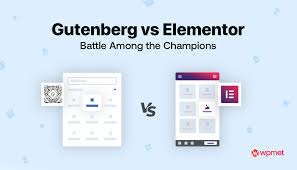WordPress has evolved. What started as a simple blogging tool now runs empires. One key part of that growth? Page builders. They shape the visual identity of websites. They decide what users see.
With respect to this, two heavyweights have risen to the top—Elementor and Gutenberg.
Both claim the crown. Both have loyal followers. But which one truly rules WordPress web design? Let’s dive into the design battlefield and find out.
Meet the Contenders
Elementor is a full-fledged page builder plugin. It boasts drag-and-drop magic and offers precise control. Designers love it. Marketers adore it. Beginners find it friendly.
Gutenberg, on the other hand, is WordPress’s built-in editor. It arrived with version 5.0. It uses a block system. Each paragraph, image, or button becomes a block. It replaced the old editor. It sparked controversy at first. Now, it grows stronger every year.
Installation and Setup
Elementor requires installation. You must download it. Activate it. Then create pages with its interface. It runs outside the native WordPress editor.
Gutenberg needs nothing extra. It lives inside WordPress. It works the moment you install the platform. No fuss. No plugin. Just open a post or page, and begin.
In essence, Elementor feels like a studio, and Gutenberg feels like a sketchpad. Both are useful. But they approach creativity differently.
User Interface Experience
Elementor greets you with a sidebar of widgets.
- Text boxes
- Images
- Slideshows
- Carousels
You drag what you want and drop it where it fits. Changes happen live without a delay or reload. The experience feels rich.
Gutenberg keeps it simple. You add blocks one at a time. The interface looks clean. It follows the WordPress web design style. Minimal distractions. Easy focus.
But here’s the twist—Gutenberg is less flashy. It doesn’t give instant flair. It gives structure. That appeals to clean design lovers. It works best for content-heavy sites.
Design Freedom
Elementor hands you the keys to the kingdom. It lets you control margins, padding, typography, colours, shadows, and animations. Everything bends to your will. You can build complex layouts without touching a line of code. Elementor handles it all.
Gutenberg focuses on consistency. It plays well with themes. But it offers fewer styling options. You need extra plugins, or custom CSS, or a developer’s help to go beyond the basics.
Speed and Performance
Speed is king. Users hate slow sites. Search engines hate them even more.
Elementor adds some weight. It loads extra CSS and JavaScript. That can slow things down, especially on mobile. You may need optimisation plugins to balance it out.
Gutenberg shines here. It runs lean. It uses native code. Pages load faster. Performance scores climb. Google approves.
If raw speed matters, Gutenberg takes the point. But Elementor can catch up—with the right tweaks.
Learning Curve
Elementor feels intuitive. New users catch on fast. The drag-and-drop style feels natural. You see changes instantly. That boosts confidence.
Gutenberg also offers ease, but it hides depth. You must explore the menus. Find hidden options. Learn shortcuts.
Still, neither one requires coding. Both welcome non-techies. Elementor feels more like a design tool. Gutenberg feels more like a writing tool. Different vibes. Same goal.
Compatibility with Themes and Plugins
Elementor plays well with most themes. But some conflicts happen. Some themes override their styles, and others break widgets.
Elementor also adds shortcodes that can create messy code. If you disable it, your content can vanish into shortcodes. Not ideal.
Gutenberg works better with core themes. It follows WordPress standards, and it means fewer issues. But not all plugins support block styling. That limits advanced layouts.
Advanced Features
Elementor boasts powerful tools. It includes –
- Motion effects
- Scroll animations
- Custom breakpoints
- Dynamic content
- WooCommerce styling
- Form builder
- Popup builder.
All in one place.
Gutenberg stays humble. It focuses on content. For more features, you need plugins like Kadence Blocks or GenerateBlocks. They add advanced elements, but that adds complexity and plugin overload.
So, Elementor wins this round. It gives more tools in one sleek package.
Cost Factor
Gutenberg is free forever. No premium version. No upgrades. Everything is included from day one.
But Elementor has a free version, which is limited. You miss many pro features. For full access, you need to pay, and plans start at around £59 per year. Still, many find it worth the price. The tools justify the investment. But for ultra-budget projects? Gutenberg is gold.
SEO Considerations
Search Engine Optimisation starts with structure, clean code, fast loading, logical headings, and mobile readiness. Gutenberg excels here. It keeps the code light by avoiding visual clutter. It also sticks to HTML standards that please Google.
Elementor adds extras—some useful, some unnecessary. If misused, those extras hurt SEO. With careful use, Elementor can match Gutenberg, but it needs effort.
So, Gutenberg wins by default.
Who Should Use Elementor?
Designers love it, and agencies rely on it. Marketing teams use it daily. Elementor is perfect for those needing –
- Bold layouts
- Unique animations
- Pixel control.
It’s ideal for landing pages, portfolios, and product showcases. In short, it’s perfect for anyone who wants more design power.
Who Should Use Gutenberg?
Writers adore it. Bloggers praise it. Developers prefer it.
Gutenberg suits minimalist needs.
- Clean sites
- Fast content
- Simple designs.
It fits publishers, journalists, schools, and nonprofits. In a nutshell, it works great for those who want performance and stability.
Final Thoughts
No one-size-fits-all answer. Elementor dazzles with design, and Gutenberg wins with speed. Elementor feels like Photoshop, while Gutenberg feels like Google Docs.
So, if you need control, effects, and layout precision—go with Elementor.
If you need speed, simplicity, and seamless integration—choose Gutenberg.
Both are brilliant. The better tool depends on your mission.
If you feel professional support will help your WordPress web design further, contact Make My Website.



